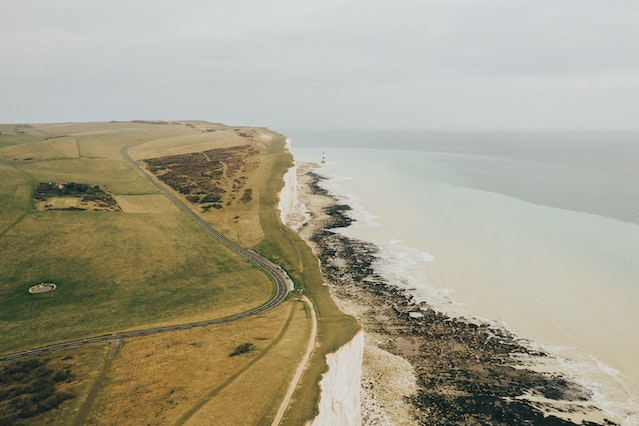Plateaus are broad elevated areas of land with flat tops and steep sides. They can be found all over the world and come in a variety of shapes and sizes. Mesas, on the other hand, are smaller tablelands with steep sides and a relatively flat top. They’re typically found in arid regions like deserts or plains.
Plateaus
(Photo by Graham Willis on Unsplash )

A plateau is a flat, elevated landform that stands above the surrounding area. It’s typically larger than a mesa and covers a much wider expanse of land. Plateaus can form in several ways, including through volcanic activity or tectonic uplift.
One example of a famous plateau is the Colorado Plateau in North America. This stunning formation spans over 337,000 square kilometers across four different states, with elevations ranging from around 1,200 to 2,900 meters above sea level.
While plateaus may seem like unremarkable stretches of land at first glance, they are often home to unique plant and animal species that have adapted to life at high altitudes. Additionally, many ancient civilizations have built their cities on plateaus due to their natural defensive advantages.
However, living on a plateau also comes with its challenges. Temperatures can be extreme due to the altitude and lack of protection from the wind, making it difficult for agriculture and farming activities in some areas. Nonetheless, plateaus remain intriguing geographic formations worth exploring!
Mesas
(Photo by Antony Trivet)

Mesas are flat-topped mountains that are typically found in arid regions. They are similar to plateaus, but smaller in size and have more steeply sloping sides. The tops of mesas can be several miles wide, providing a perfect location for hiking, camping or even constructing homes.
What distinguishes mesas from other landforms is their unique geologic history. Mesas were formed through the process of erosion when softer sedimentary rock was worn away by wind and water leaving behind harder layers of rocks such as sandstone or limestone.
Mesas also provide important habitats for wildlife due to their isolated nature which provides protection from predators. The isolation can pose challenges for human habitation since access may be limited, making it difficult to transport supplies and construct infrastructure.
Despite these challenges, people still choose to live on mesas because they offer stunning views of the surrounding landscape with easy access to outdoor activities like hiking and rock climbing. With careful planning and preparation, living on a mesa can be an enjoyable experience for those who crave adventure and appreciate natural beauty.
Plateau Vs. Mesa – Key differences
When it comes to geology, the terms plateau and mesa are often used interchangeably, but they actually refer to two different landforms. Plateaus are large flat areas of high ground that rise steeply from surrounding lowlands, while mesas are smaller flat-topped hills or mountains with cliff-like sides.
One of the key differences between plateaus and mesas is their size. Plateaus can span hundreds or even thousands of miles, while mesas typically only cover a few square miles at most. Another difference lies in their formation – plateaus generally form as a result of tectonic uplift or erosion by water and wind over long periods of time, while mesas usually form through volcanic activity.
Another important distinction between these landforms is their location – plateaus tend to be located in more remote regions like deserts or high mountain ranges, whereas mesas can be found in both rural and urban settings.
Visually speaking, one way to tell the difference between a plateau and a mesa is by looking at their edges – plateaus have gradual slopes leading up to them whereas mesas have sheer cliffs on all sides.
How to tell the difference between a plateau and a mesa
One of the easiest ways to differentiate between a plateau and a mesa is by looking at their shape. A plateau has a relatively flat surface that rises abruptly from the surrounding land, while a mesa looks like an elevated table with steep sides and a flat top.
Another way to distinguish between these two geological formations is by evaluating their size. While plateaus can extend for hundreds or thousands of miles, mesas are generally smaller in size.
You can also tell the difference by examining how they were formed. Plateaus are usually created when tectonic plates collide or through volcanic activity, while mesas form due to erosion caused by water or wind.
If you happen to be standing atop one of these geological formations, you might notice other differences as well. For instance, mesas tend to have more varied terrain on their surfaces compared to plateaus, which often have uniform landscapes.
Whether it’s through shape, size or formation process – understanding these differentiating factors will help you accurately identify whether the landform beneath your feet is a plateau or mesa.
The benefits of living on a plateau or mesa
Living on a plateau or mesa can have its advantages, especially if you’re someone who enjoys stunning views and a peaceful lifestyle. For instance, mesas offer an undisturbed view of the surrounding landscape since they are generally flat-topped mountains with steep sides.
Additionally, plateaus can be great for agriculture as the soil tends to be fertile due to years of erosion and deposits from water sources. This provides local farmers with ample opportunities to grow crops and raise livestock.
Moreover, living at higher elevations such as those found on plateaus or mesas has been linked to improved respiratory health because of cleaner air quality in comparison to lower-altitude regions.
Furthermore, these natural formations also provide excellent recreational opportunities like hiking trails with breathtaking vistas where people can enjoy beautiful sunsets/sunrises or observe wildlife in their natural habitat.
Living on a plateau may offer some protection against flooding which is often associated with low-lying areas near rivers and coastlines. With all these benefits considered together it’s easy to see why many people choose to call high-elevation landforms home.
The drawbacks of living on a plateau or mesa
Living on a plateau or mesa may seem like a dream come true for some, but it’s not all sunshine and rainbows. There are certain drawbacks that come with the territory of living at a higher elevation.
One major disadvantage is the harsh weather conditions. Plateaus and mesas are exposed to strong winds which can make life difficult for residents. The high altitude also means that temperatures can drop significantly, making it challenging to keep homes warm in winter.
Another drawback is the limited access to water resources. Water sources on a plateau or mesa tend to be scarce due to the lack of rainfall and underground aquifers. This can make it hard for residents who rely on agriculture as their main source of income.
Living at higher altitudes also presents health risks such as altitude sickness, especially if you’re not used to living at such heights. It’s important for those considering moving onto a plateau or mesa to consult their doctor before making any decisions.
Being isolated from urban areas can be another challenge when residing on plateaus and mesas. Accessing basic amenities like hospitals, schools and grocery stores could take hours depending on where one lives. This makes daily life more challenging, especially if there are emergencies.
Despite these challenges, many people continue living in these unique terrains because they offer stunning views and peaceful environments – something that cannot easily be found elsewhere!
What are the types of Plateaus?
Plateaus are categorized based on how they were formed, their elevation, and the surrounding environment. There are several types of plateaus around the world.
The first type is a dissected plateau, which is characterized by steep slopes and deep valleys. These usually occur in areas with high rainfall, where rivers have cut through the plateau over millions of years.
Another type of plateau is a volcanic plateau that forms as a result of volcanic activity. Volcanic eruptions deposit lava and ash on the surface, eventually building up into large flat-topped areas.
Tectonic plateaus form when two tectonic plates collide or move apart from each other. As these forces push against each other, land masses rise or sink to create high-elevation regions.
There are erosional plateaus formed from long-term erosion caused by wind or water action. This can happen in arid regions like deserts where consistent winds lead to sandstone formations shaped like table-like structures called “tablelands”.
Featured Image By – Photo by JACK REDGATE









